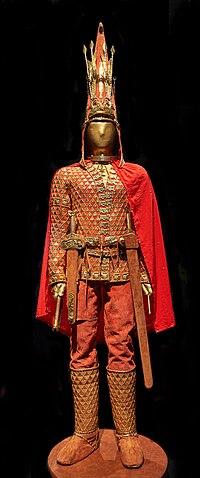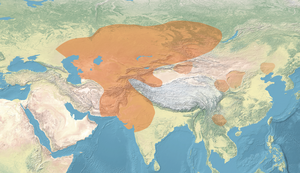
Back ሳካዎች Amharic ساكا Arabic Saklar Azerbaijani Сактар (ҡәбиләләр) Bashkir Сакі (народ) Byelorussian শক (জনগোষ্ঠী) Bengali/Bangla Saces Catalan Sakové Czech Саккисем CV Saken German
This article may require copy editing for grammar, style, cohesion, tone, or spelling. (February 2024) |
Map of the Saka realm ( ) and main Saka polities throughout their history.[1][2][3][4] The affiliation of the easternmost Scythoïd cultures (Subeshi culture, Ordos culture, Majiayuan, Upper Xiajiadian or Dian) remains uncertain. | |
| Geographical range | Central Asia, South Siberia, South Asia |
|---|---|
| Dates | 9th century BC to 5th century AD |
| Preceded by | Andronovo culture, Seima-Turbino phenomenon, Karakol culture, Karasuk culture, Deer stones culture |
| Followed by | Xiongnu, Kushan Empire, Gupta Empire |

The Saka[a] were a group of nomadic Eastern Iranian peoples who lived in the Eurasian Steppe and the Tarim Basin from the 9th century BC to the 5th century AD.[7][8] The Saka were closely related to the Scythians, and both groups formed part of the wider Scythian cultures.[9] However, they are distinguished from the Scythians by their specific geographical and cultural traits.[8][10] The Saka languages formed part of the Scythian phylum, a branch of the Eastern Iranian languages.
Derived from the earlier Andronovo, Sintashta and Srubnaya cultures, the Saka were later influenced by the Bactria-Margiana Archaelogical Culture and Iron Age East Asian genetic influx.[11][12] The ancient Persians, ancient Greeks, and ancient Babylonians respectively used the names "Saka," "Scythian," and "Cimmerian" for all the steppe nomads. However, the name "Saka" is used specifically for the ancient nomads of the eastern steppe, while "Scythian" is used for the related group of nomads living in the western steppe.[8][13][14]
Prominent archaeological remains of the Sakas include Arzhan,[15] Tunnug,[16] the Pazyryk burials,[17] the Issyk kurgan, Saka Kurgan tombs,[18] the Barrows of Tasmola[19] and possibly Tillya Tepe. In the 2nd century BC, many Sakas were driven by the Yuezhi from the steppe into Sogdia and Bactria and then to the northwest of the Indian subcontinent, where they were known as the Indo-Scythians.[20][21][22] Other Sakas invaded the Parthian Empire, eventually settling in Sistan, while others may have migrated to the Dian Kingdom in Yunnan, China. In the Tarim Basin and Taklamakan Desert of today's Xinjiang Uyghur Autonomous Region, they settled in Khotan, Yarkand, Kashgar and other places.[23]
- ^ Davis-Kimball, Jeannine; Bashilov, V. A.; I︠A︡blonskiĭ, Leonid Teodorovich (1995). Nomads of the Eurasian Steppes in the Early Iron Age (PDF). Zinat Press. p. IX, Map 1.
- ^ Atlas of World History. Oxford University Press. 2002. p. 51. ISBN 978-0-19-521921-0.
- ^ Fauve, Jeroen (2021). The European Handbook of Central Asian Studies. BoD – Books on Demand. p. 403. ISBN 978-3-8382-1518-1.
- ^ Haywood, John (1997). Atlas of world history. New York : Barnes & Noble Books. pp. Map 22. ISBN 978-0-7607-0687-9.
- ^ Chang, Claudia (2017). Rethinking Prehistoric Central Asia: Shepherds, Farmers, and Nomads. Routledge. p. 72. ISBN 978-1-351-70158-7.
- ^ Rhie, Marylin M. (2002). Early Buddhist art of China and Central Asia. Leiden: Brill. p. Fig. 5.70d. ISBN 978-90-04-11499-9.
Fig. 5.70d Gold mail suit, crown and leg covers, from an Issik tomb, period of the Saka tribes, 5th to 4th century B.C., Institute of Archaeology, History and Ethnography, Alma-Ata, Kazakhstan (after Shiruku rodo no yuihO, pl. 18)
- ^ Beckwith 2009, p. 68 "Modern scholars have mostly used the name Saka to refer specifically to Iranians of the Eastern Steppe and Tarim Basin"
- ^ a b c Dandamayev 1994, p. 37 "In modern scholarship the name 'Sakas' is reserved for the ancient tribes of northern and eastern Central Asia and Eastern Turkestan to distinguish them from the related Massagetae of the Aral region and the Scythians of the Pontic steppes. These tribes spoke Iranian languages, and their chief occupation was nomadic pastoralism."
- ^ Unterländer et al. 2017: "During the first millennium BC, nomadic people spread over the Eurasian Steppe from the Altai Mountains over the northern Black Sea area as far as the Carpathian Basin... Greek and Persian historians of the 1st millennium BCE chronicle the existence of the Massagetae and Sauromatians, and later, the Sarmatians and Sacae: cultures possessing artefacts similar to those found in classical Scythian monuments, such as weapons, horse harnesses and a distinctive 'Animal Style' artistic tradition. Accordingly, these groups are often assigned to the Scythian culture..."
- ^ Kramrisch, Stella. "Central Asian Arts: Nomadic Cultures". Encyclopædia Britannica Online. Retrieved 1 September 2018.
The Śaka tribe was pasturing its herds in the Pamirs, central Tien Shan, and in the Amu Darya delta. Their gold belt buckles, jewelry, and harness decorations display sheep, griffins, and other animal designs that are similar in style to those used by the Scythians, a nomadic people living in the Kuban basin of the Caucasus region and the western section of the Eurasian plain during the greater part of the 1st millennium bc.
- ^ Gnecchi-Ruscone, Guido Alberto (26 March 2021). "Ancient genomic time transect from the Central Asian Steppe unravels the history of the Scythians". Science Advances. 7 (13). Bibcode:2021SciA....7.4414G. doi:10.1126/sciadv.abe4414. ISSN 2375-2548. PMC 7997506. PMID 33771866.
- ^ Kumar, Vikas; Wang, Wenjun; Zhang, Jie; Wang, Yongqiang; Ruan, Qiurong; Yu, Jianjun; Wu, Xiaohong; Hu, Xingjun; Wu, Xinhua; Guo, Wu; Wang, Bo; Niyazi, Alipujiang; Lv, Enguo; Tang, Zihua; Cao, Peng (April 2022). "Bronze and Iron Age population movements underlie Xinjiang population history". Science. 376 (6588): 62–69. Bibcode:2022Sci...376...62K. doi:10.1126/science.abk1534. ISSN 0036-8075. PMID 35357918. S2CID 247855352.
Of these, the Sakas were the descendants of Late Bronze Age (LBA) herders (such as the Andronovo, Srubnaya, and Sintashta) with additional ancestries derived from Lake Baikal (Shamanka_EBA) (EBA, Early Bronze Age) and BMAC populations (1, 17, 18). Sakas have been associated with the Indo-Iranian Khotanese language, which was spoken in southern Xinjiang before spreading to other parts of the region (19).
- ^ David & McNiven 2018: "Horse-riding nomadism has been referred to as the culture of 'Early Nomads'. This term encompasses different ethnic groups (such as Scythians, Saka, Massagetae, and Yuezhi)..."
- ^ Diakonoff 1985: the Persians called "Saka" all the northern nomads, just as the Greeks called them "Scythians", and the Babylonians "Cimmerians".
- ^ Zaitseva, G. I.; Chugunov, K. V.; Alekseev, A. Yu; Dergachev, V. A.; Vasiliev, S. S.; Sementsov, A. A.; Cook, G.; Scott, E. M.; Plicht, J. van der; Parzinger, H.; Nagler, A. (2007). "Chronology of Key Barrows Belonging to Different Stages of the Scythian Period in Tuva (Arzhan-1 and Arzhan-2 Barrows)". Radiocarbon. 49 (2): 645–658. Bibcode:2007Radcb..49..645Z. doi:10.1017/S0033822200042545. ISSN 0033-8222.
- ^ Caspari, Gino; Sadykov, Timur; Blochin, Jegor; Hajdas, Irka (1 September 2018). "Tunnug 1 (Arzhan 0) – an early Scythian kurgan in Tuva Republic, Russia". Archaeological Research in Asia. 15: 82–87. doi:10.1016/j.ara.2017.11.001. ISSN 2352-2267. S2CID 135231553.
- ^ Dergachev, V. A.; Vasiliev, S. S.; Sementsov, A. A.; Zaitseva, G. I.; Chugunov, K. A.; Sljusarenko, I. Ju (2001). "Dendrochronology and Radiocarbon Dating Methods in Archaeological Studies of Scythian Sites". Radiocarbon. 43 (2A): 417–424. Bibcode:2001Radcb..43..417D. doi:10.1017/S0033822200038273. ISSN 0033-8222.
- ^ Panyushkina, Irina; Grigoriev, Fedor; Lange, Todd; Alimbay, Nursan (2013). "Radiocarbon and Tree-Ring Dates of the Bes-Shatyr #3 Saka Kurgan in the Semirechiye, Kazakhstan". Radiocarbon. 55 (3): 1297–1303. Bibcode:2013Radcb..55.1297P. doi:10.1017/S0033822200048207. hdl:10150/628658. ISSN 0033-8222. S2CID 220661798.
- ^ Beisenov, Àrman Z.; Duisenbay, Daniyar; Akhiyarov, Islam; Sargizova, Gulzada (1 October 2016). "Dromos Burials of Tasmola Culture in Central Kazakhstan". The Anthropologist. 26 (1–2): 25–33. doi:10.1080/09720073.2016.11892125. ISSN 0972-0073. S2CID 80362028.
- ^ Benjamin, Craig (March 2003). "The Yuezhi Migration and Sogdia". Ērān ud Anērān Webfestschrift Marshak. Archived from the original on 18 February 2015. Retrieved 1 March 2015.
- ^ "Chinese History – Sai 塞 The Saka People or Soghdians". Chinaknowledge. Archived from the original on 19 January 2015. Retrieved 1 March 2015.
- ^ Beckwith 2009, p. 85 "The Saka, or Śaka, people then began their long migration that ended with their conquest of northern India, where they are also known as the Indo-Scythians."
- ^ Cite error: The named reference
Sinor_173was invoked but never defined (see the help page).
Cite error: There are <ref group=lower-alpha> tags or {{efn}} templates on this page, but the references will not show without a {{reflist|group=lower-alpha}} template or {{notelist}} template (see the help page).

